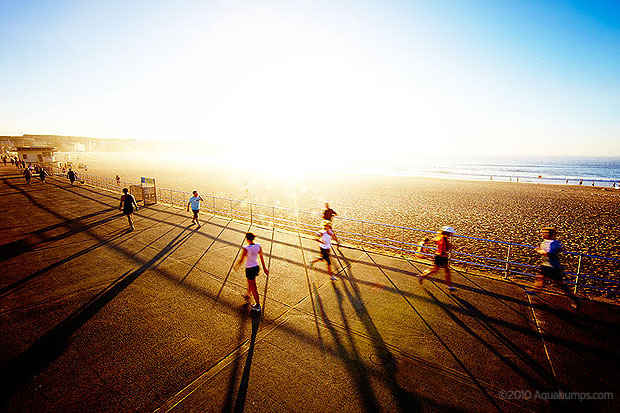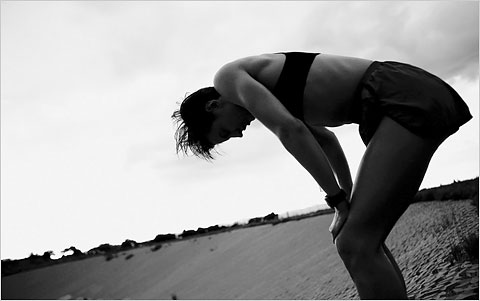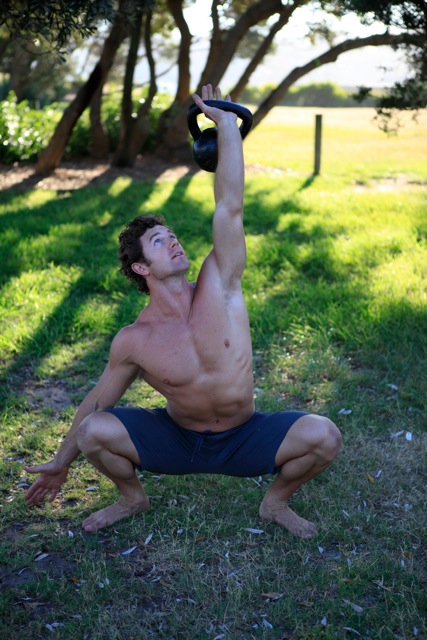Reader Amy recently asked what I do for exercise.
This is a really good question. Because I’ve shifted the way I do things in the past six months or so. Dramatically so. And I think what I’ve learned (the hard way…always the hard way with me) works. For everyone. It’s not that complicated…and it’s kind.
To start, I should tell you what I used to do. I would run 10-14km every few days, run to yoga class twice a week, run to the beach to sand run, run to the gym, run 10km to work…oh, and go mountain running most weekends. I’d also go mountainbike racing…I’d compete in 24 hour races.
Got a picture? I’m not boasting. I’m kind of embarrassed.
I ran. From? Not sure…mostly myself and my fear of stillness.
In the end my adrenals couldn’t handle it any more and I collapsed. Bam! I ground to a halt and couldn’t walk for several months. I’ve written about this before. Quelle irony, hey! Our bodies do this. They teach us the perfect lessons we need right now. My lesson: stop! Rethink!
As I got better, I tried to go back to my old ways. Stubborn goat girl that I am. Each and every time, though, I’d get an injury – in my neck, my toe, or a cold or whatever. My body was rebelling. It was super shitty.
I finally got the picture. So. Now. I take a far more gentle approach. Below is what works now.
my principles
* Exercise/move every day. It’s the “every day” part of that statement that matters, not how much, or what you do. Once you start allowing “off” days….you allow the “off” days to grow. And, really, exercise should just be about moving. It should be part of life every day. Not a regime you shirk from. Treat it as such.
* Sometimes I just walk. Or stretch in the morning.
* I just commit to doing 20 minutes of something. I get out the door and move. If I start moving and want to do it longer, great. If not, 20 minutes is cool.
* I exercise in the morning. Then it’s done. I also exercise/move to feel fresh. To get energy. This is the point. My day feels dull without this kick-start. THIS is what gets me out of the bed. Any incidental walking on top of what I do in the morning is a bonus.
* I don’t make a fuss. I tie on my shoes and get out of the house. No fancy gear or water bottles or towels. Driving to gyms and groups across town are just hurdles that can stop you from just moving. Keep it as simply and as close to home as possible. I put my key down my bra and carry nothing. No ipod, no phone. Out the door!
* I exercise to feel good and clear in the morning. Not to lose weight. Not because I don’t need to. But because when you prioritise weightloss, the effects are delayed and so you lose love for yourself. Which leads me to….
know this: exercise doesn’t really help you lose weight anyway
David Gillespie outlines this in his book ‘Sweet Poison’, which I’ve become a little partial to:
Our (bodies are) super food converters. They turn every edible part of food (everything except fibre) into energy. Anything we don’t immediately need for energy is stored as body fat for later use. Our efficient energy use means that increasing the amount of physical exercise we do is significantly less effective at reducing fat storage than consuming less energy in the first place.
So, basically, we are designed to not burn off that much energy from exercising….in caveman days this made sense. So…to travel 8km on a bicycle we only need about 10 tsp of sugar (the amount in a can of soft drink). To travel 8km in a car, we’d need about 1kg of sugar of energy (about 200 tsps!!!!!).
Equally: we need to swim laps for an hour to burn a chocolate bar, and run 6km to burn through a burger.
Exercising and dieting help lower weight gain, but it will always be a losing battle for as long as we consume fructose. To burn an extra 14kgs off your body and then maintain that weight (the amount we gain from eating the average amount of fructose consumed in Australia) you’d need to run 7kms every single day of the year. Yes, even on weekends.
High-octane cardio is particularly counter-productive. We were never meant to run for an hour, evolutionarily speaking. Why? As cavemen and cavechicks we only needed short, sharp energy spurts to escape tigers etc. Or to hunt a buffalo. We were never going to be able to outrun a tiger for an hour. So we didn’t develop abilities to do so. Instead, we evolved to put more energy to our brains so we could outsmart the tiger. That said, I think very slow jogging over long distances makes sense. A long, gentle jog/shuffle in the bush every now and then personally makes me happy.
So, 20-30 mins of good, solid exercise a day is best. Any more can be wasted if it’s a struggle for you. It rusts!
Yes, too much oxygen sucked into our system oxidises our cells, just as air oxidises metal. It rusts our systems. Have you noticed how old hard-core runners look?!!
Kat Eden wrote recently about how cardio just makes us eat more. She’s cut cardio out of her life and it’s made her much more ‘well’.
how I train now:
* I do a Vinyasa yoga class once or twice a week. When I’m in Sydney it’s at Dharma Shala. The vinyasa style suits me – strong, but a continual flow, which is soothing for adrenal, thyroidy types! I do it at home if I can’t make a class.
* I swim twice a week for about 20 minutes. When in Sydney – at Icebergs pool. Up here, locals swim a lap of Clarke’s beach at Byron in the mornings. Or I do a stand up paddle with the Bondi Rescue guys on the beach (again, when in Sydney). I’ll swim when my neck plays up or if I’m feeling thyroidy (puffy, inflamed). It cools and soothes. Afterward I sit in the sun and meditate by the ocean. It’s part of the ritual. Having nice exercise add-ons like this helps me stay motivated.
* I walk. On weekends I head out bush and do 10km walks in trees, over rocks. I love it. I stick a map and my key down my running bra and off I go. Or I walk to a park and meditate. Then walk home. I walk to meetings in the city. I walk to dinner. I walk whenever I can. Mostly, it’s faster than driving, door-to-door. I wear these walking shoes for extra lift.
* I sand run every now and then. It’s lovely and rhythmic. I go slow. And enjoy it for the view of the ocean and the feel of the sand.
* I ride my bike as often as is comfortable, as transport. I ride most days, one way or another. My bike comes with me everywhere.
* I do bush shuffles. I head off to a national park and do a 10km bushwalk every few weeks. I sort of scamper-slash-walk-jog. It’s more to clear my head and get happy.
* And finally….
my origin of energy training
I’ve been training with these kids for about 5 weeks, 2-3 times a week. Aaron, the dude who started the Origin of Energy project, is on the same page as me. He, too, got an autoimmune disease a few years back and was forced to rethink. His approach now is this: exercise hard 3-4 times a week for 20-30 minutes. The rest of the week do gentle movement, like swimming or walking or gentle yoga. Because this is how we’re designed to move.
We train barefoot. We use our body weight as weights and kettle bells and ropes and chin-up bars. We train for 25 minutes, plus ab work and stretching.
As an aside, Aaron got Anthony Minichiello back on track after his back injury. And works with ballet dancers and runners. They did an ACA segment on it some time back.
This is the delightful Aaron!
The OOE team make coconut smoothies for everyone after. They sell locally sourced “caveman” staples like raw yoghurt, homemade kefir, berries, meat and activated nuts there, too. They also do workshops on farming and cooking and primitive eating. Marty Boetz who owns Longrain restaurant works with them on the food side of things.
It’s BASIC. And it makes sense. I don’t get tired or bored. Nor do I get injuries.
Up here while I’m writing I’ve been doing the workouts using two bottles of tequila as hand weights and my Le Creuset pot filled with coins as a dead weight. On their site they’ve posted workouts that can be done without weights.
Aaron says: “We train the body in the way nature intended, we use tools and programs that make you stronger, faster, more agile and more equipped to handle fatigue. Short intense whole body movements followed by core corrective training are the perfect solution for the modern sedentary life most of us live.”
Yeehah.
His approach taps into this “caveman” thinking – that our biology hasn’t changed in 130,000 years, so it’s often best to emulate what our ancestors did simply because it’s what we were designed to do.
I’ll write more on this again soon. If you’re interested. I’ll also post some videos that Aaron’s going to make for exercising at home without weights. Interested? Got any other exercise tips or questions? Please share!




